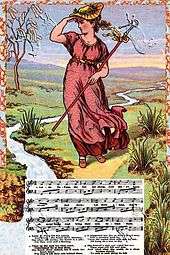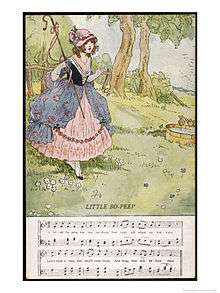Little Bo Peep
| "Little Bo Peep" | |
|---|---|
| Roud #6487 | |
 | |
| Song | |
| Written | England |
| Published | c. 1805 |
| Form | Nursery rhyme |
| Writer(s) | Traditional |
| Language | English |
 |
Little Bo Peep
Main melody for "Little Bo Peep" |
| Problems playing this file? See media help. | |
"Little Bo Peep" or "Little Bo Peep has lost her sheep" is a popular English language nursery rhyme. It has a Roud Folk Song Index number of 6487.
Lyrics and melody
As with most products of oral tradition, there are many variations to the rhyme. The most common modern version is:
- Little Bo-Peep has lost her sheep,
- and doesn't know where to find them;
- leave them alone, And they'll come home,
- wagging their tails behind them.[1]

Common variations on second line include "And can't tell where to find them." The fourth line is frequently given as "Bringing their tails behind them",[2] or sometimes "Dragging their tails behind them". This alternative version is useful in the extended version, usually of four further stanzas. The melody commonly associated with the rhyme was first recorded in 1870 by the composer and nursery rhyme collector James William Elliott in his National Nursery Rhymes and Nursery Songs.[3]
Additional verses

The following additional verses are often added to the rhyme:
- Little Bo-peep fell fast asleep,
- and dreamt she heard them bleating;
- but when she awoke, she found it a joke,
- for they were still a-fleeting.
- Then up she took her little crook,
- determined for to find them;
- she found them indeed, but it made her heart bleed,
- for they'd left their tails behind them.
- It happened one day, as Bo-peep did stray
- into a meadow hard by,
- there she espied their tails side by side,
- all hung on a tree to dry.
- She heaved a sigh and wiped her eye,
- and over the hillocks went rambling,
- and tried what she could, as a shepherdess should,
- to tack each again to its lambkin.[1][2]
Origins and history
The earliest record of this rhyme is in a manuscript of around 1805, which contains only the first verse.[1] There are references to a children's game called "Bo-Peep", from the 16th century, including one in Shakespeare's King Lear (Act I Scene iv), but little evidence that the rhyme existed.[1] The additional verses are first recorded in the earliest printed version in a version of Gammer Gurton's Garland or The Nursery Parnassus in 1810.[1]
The phrase "to play bo peep" was in use from the 14th century to refer to the punishment of being stood in a pillory. For example, in 1364, an ale-wife, Alice Causton, was convicted of giving short measure, for which crime she had to "play bo pepe thorowe a pillery".[4] Andrew Boorde uses the same phrase in 1542, "And evyll bakers, the which doth nat make good breade of whete, but wyl myngle other corne with whete, or do nat order and seson hit, gyving good wegght, I would they myghte play bo pepe throwe a pyllery".[5]
In popular culture

In O. Henry’s romantic story “Madame Bo-Peep, of the Ranches” Octavia Beaupree comes to the Rancho de las Sombras in Texas, the only real property she inherits after the bankruptcy and death of her husband, Colonel Beaupree. Her old friend and unsuccessful admirer Teddy Westlake who works at the ranch as a manager calls her by the name of Mother Goose's heroine, the Mexican workers call her “La Madama Bo-Peepy” and the ranch becomes known as “Madame Bo-Peep's ranch”. Finally, Octavia accepts Teddy’s proposal, he chants the first quatrain of the nursery rhyme, after the third line she draws his head down, whispers in his ear and the story ends with the words “But that is one of the tales they brought behind them.”
- Bo Peep is the female lead in the 1934 film Babes in Toyland. The character also appears in the 1961 film version, portrayed by a young Ann Jillian, but not as a leading character.
- The character appears as "Bo Peep," a ceramic doll, in the animated film series Toy Story voiced by Annie Potts.
- In the 1950s, comedian Johnny Standley recorded a line-by-line commentary on the original 4-line poem, titled "It's in the Book." He ridicules what he sees as the simplistic attitude of the person addressing Bo Peep, and ends his commentary with (poem quotes in italics) "They will come home, a-waggin' their tails. Pray tell me, what else could they wag? They will come home a-waggin' their tails... behind them. Behind them! Did we think they'd wag them in front? Of course, they might've come home in reverse."[6]
- In the anime Bobobo-bo Bo-bobo she is given the name "Little Bobobo-Peep."
- In the continuity of the Fables comic book from Vertigo, she is the wife of Peter Piper, and lives in Fabletown's northern branch, the "Farm." Her story, along with that of Peter and his evil brother Max (the future Pied Piper of Hamelin), is told in Bill Willingham's novel Peter & Max: A Fables Novel.
- In the 1980s television series, The Dukes of Hazzard, the Daisy Duke character used the name, "Bo Peep" as her CB Radio handle.
- In the 1986 Kidsongs video "A Day with the Animals" the Kidsongs Kids recorded their version of the song Little Bo Peep.
- Little Bo Peep was one of the seven magical events to feature on the Teletubbies, whereby string puppets were used to illustrate the nursery rhyme. Little Bo Peep went in search of her sheep who hid themselves around Tellytubby Land.
- In the 2000 TV miniseries The 10th Kingdom, the protagonists find themselves in a village in the fairytale kingdom where Bo Peep's descendants have diverted the magic water that was once used to bring prosperity to the village via the local wishing well; protagonist Tony Lewis learns this secret and uses the well to transform a sheep into a champion and restore Prince Wendell White- Snow White's grandson, trapped in the form of a dog and turned into a gold statue by accident- back into a living state. At the storyline's conclusion, the diverted well-water is restored to its original route when Sally Peep, bitter at losing the annual sheep competition, destroys her grandfather's dam.
- In the 2006 animated film Hoodwinked, when the Wolf interrogates his informant, a sheep named Woolworth, Woolworth describes Red Puckett as a "sweet gal, not like that Bo Peep", complaining that "that brat put up an invisible fence, I tasted metal fillings for a week!"
- In the TV series Once Upon a Time episode "White Out," Bo Peep (portrayed by Robin Weigert) is a female warlord in the Enchanted Forest who collects payments on farmers who own livestock, including sheep, and brands those who defy her as her property with her shepherd's crook. In Storybrooke, she works as a butcher at Chop Shop. One day, she is visited by David and Captain Hook, asking for her help. She refuses to help him, demanding that she owes him none. David interrogates her demanding to know about Anna, whom she branded years ago. Claiming that she had branded many people and that she couldn't remember the girl, David instructs Hook to take her crook. Angered by their actions, Bo Peep mocks David for being a hero in this world.
- In the book series The Land of Stories by Chris Colfer, Little Bo Peep is a farmer, living in the Red Riding Hood Kingdom, who aspires to become queen. Red Riding Hood keeps annoying her by mentioning that Little Bo once lost all her sheep.
Notes
| Wikimedia Commons has media related to Little Bo Peep. |
- 1 2 3 4 5 I. Opie and P. Opie, The Oxford Dictionary of Nursery Rhymes (Oxford University Press, 1951, 2nd edn., 1997), pp. 93-4.
- 1 2 "Little Bo Peep Rhyme". Retrieved 7 September 2013.
- ↑ J. J. Fuld, The Book of World-Famous Music: Classical, Popular, and Folk (Courier Dover Publications, 5th edn., 2000), ISBN 0486414752, p. 502.
- ↑ Salzman (1913). English Industries of the Middle Ages (PDF). London: Constable & Co., Ltd. p. 188.
- ↑ Boorde, Andrew (1870). F.J. Furnivall, ed. A Dyetary of Helth. London: Early English Text Society. p. 260 n.
- ↑ It's in the Book - John Standley (audio recording). Capitol Records. 1952. BMI Work #744156. Retrieved 25 October 2015.
filename: JohnnyStandleyItsInTheBook.wav